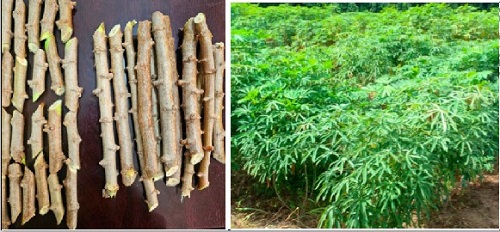Cassava holds a significant role as a staple food security crop and a source of income in Ghana.
However, due to the global starch demand, cassava is increasingly being viewed more as an industrial and income-generating crop rather than a food security crop.
There are sustainable options for producing planting materials and agroecological methods for sustaining soil nutrition and yield.
These elements are crucial for efficient cassava cultivation, which can enhance livelihoods, while preserving land resources for future generations amidst climate change.
Planting production, land-use issues
To enhance and increase stakes production, it is recommended to use short cassava cuttings of two nodes instead of the current longer cuttings with more than seven nodes, used by farmers, which lead to wastage.
These two-node cuttings can be pre-sprouted in an appropriate medium before planting on the field to ensure a good stand and uniformity in the establishment of the cassava at the field.
To prevent land conflicts and struggles for cassava production, practice intercropping with other food crops rather than mono cropping of cassava.
Splitting of land and rotating with legumes would not only improve soil fertility, it would also sustain the production of legumes such as cowpea, groundnut etc. for improved food security.
This would ensure equitable land use for a variety of crop production, while improving biodiversity than mono-cropping of cassava to address land-use issues.
Enhancing soil, productivity
As per the FAO Statistical database, cassava production in Ghana has been increasing, with a minor contribution from yield improvement, suggesting that increases are due to the expansion of the area under production rather than yield per unit area.
Given that cassava, a root and tuber crop is a heavy feeder of soil nutrients and that land resources in Ghana are limited, it is crucial to focus efforts on maintaining cassava productivity on a limited land resource to tackle the issue of land degradation associated with its production.
Variaties
To enhance cassava productivity, farmers have been encouraged to adopt improved cassava varieties.
However, the performance of any released improved cassava variety is significantly influenced by the accompanying agronomic package. For instance, cassava farmers who adopted the Root and Tuber Improvement and Marketing Programme (RTIMP) technology of improved planting materials and agronomic packages experienced increased productivity.
Therefore, in addition to developing improved varieties, research systems have developed complementary improved agronomic technologies.
These include minimum tillage, spacing, planting density, fertiliser application, use of cover and green manure, weed control, disease control among others.
Minimum tillage
The practice of minimum tillage in cassava production is strongly recommended. Farmers are advised to slash but not burn their entire farm, instead practising spot burning when necessary. Minimum tillage is especially recommended in sandy soils to conserve soil moisture and reduce soil erosion.
A recommended plant population of 10,000 plants/ha with 1x 1m for the sole cassava crop is recommended.
However, a wider row spacing (up to two m between rows) and closer in-the-row spacing (down to 0.5 m) is recommended for intercropping. While cassava can thrive better than most other crops in impoverished soils, the crop does respond well to both inorganic and organic fertilisers.
An inorganic fertiliser application rate of 200 kg of N-P2O5-K2O 15-15-15/ha or 20 g per plant is recommended.
Intercropping
Intercropping or rotation with legumes and green manure can improve the nitrogen status of the soil through nitrogen fixation.
In areas where ploughing is used, farmers are advised to plough leguminous cover crops, such as, mucuna to improve the soil’s organic matter and nutrition.
Mucuna, also known as mucuna pruriens, is a plant in the legume family that is native to the tropical and subtropical regions of the world. The plant is also known as the ‘velvet bean’ due to the hairs that cover its seedpods.
Animal manure, such as, cow dung, poultry droppings and other livestock dung can also be applied during land preparation. These approaches would sustain soil and cassava productivity on limited land resources to address deforestation and land degradation.
Conclusion
Cassava production as an industrial and income generation crop to improve livelihood is possible. However, integration with other crops and rotation with legumes would reduce its negative implications on food security.
The use of two-node cuttings of improved varieties and accompanying agronomic packages would improve cassava production in the face of limited land resources and climate change in Ghana.
The writer is a Snr Research Scientist, Crops Research Institute, Council for Scientific and Industrial Research (CSIR)
E-mail: ericdany7@gmail.com

